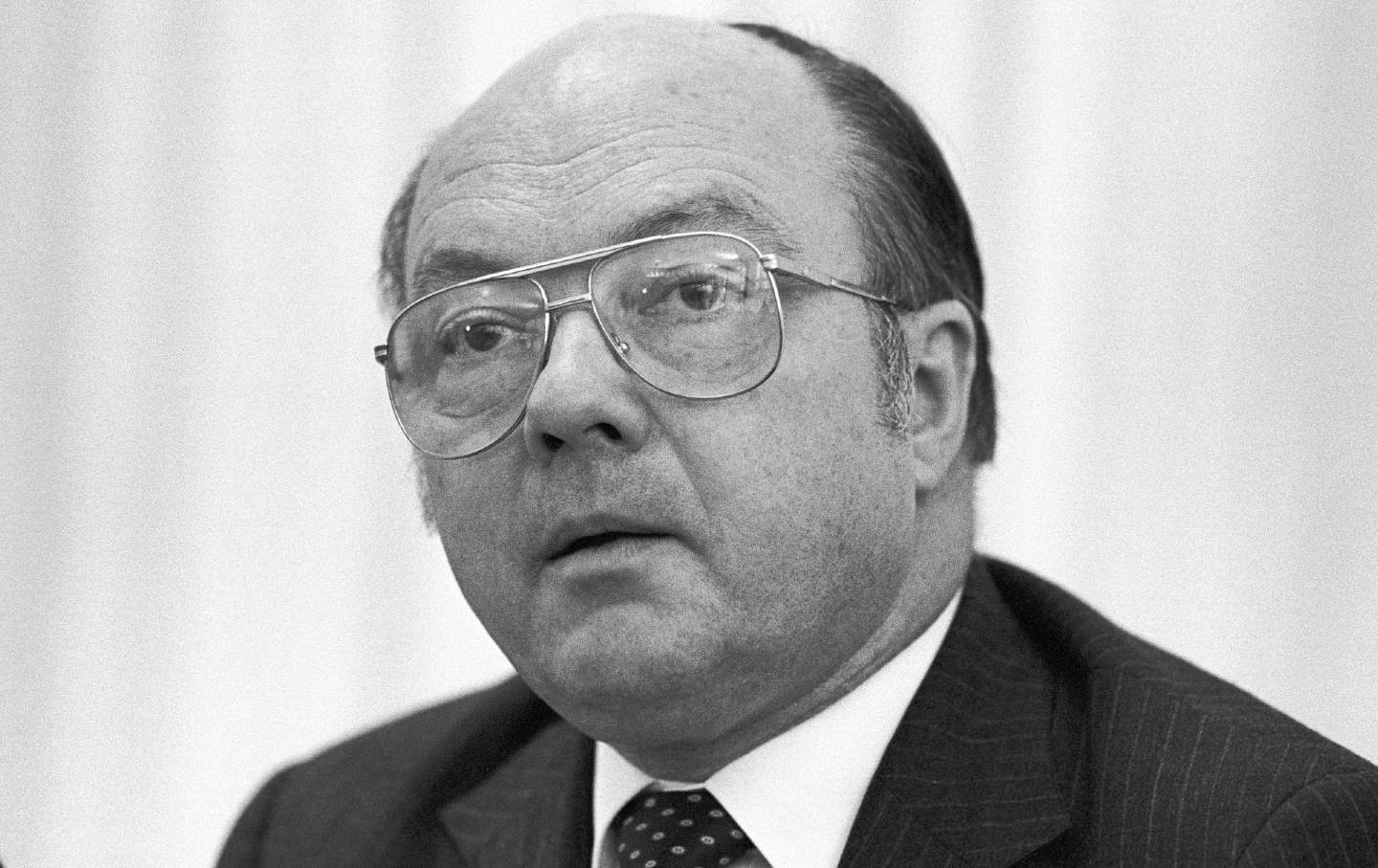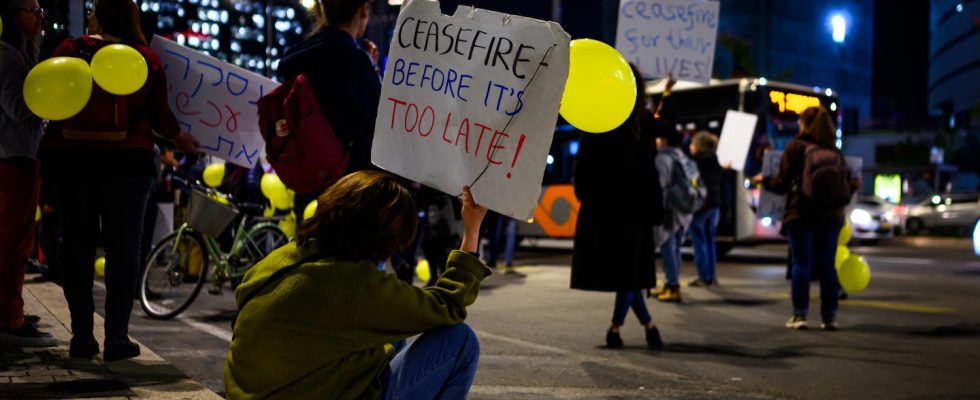After months of not using the term at all, the administration has embraced it, but is using it in a way that has little to do with what activists are demanding.
The pressure to back a cease-fire is immense, but the White House is unwilling to heed this call because it’s ideologically committed to Israel’s campaign of depopulation and destruction in Gaza. Instead, the Biden administration has decided to simply redefine what a “cease-fire” means. In a speech on Sunday, Vice President Kamala Harris did exactly that, calling for “an immediate cease-fire…for at least the next six weeks.” Using slippery language and deliberately vague rhetoric, the administration has subtly shifted this term away from its widespread popular meaning of an end to the Israeli bombing and siege to a temporary pause for hostage exchanges, followed by a recommencement of the conflict and return to Israel’s starvation and bombing campaign. And mainstream media outlets are letting them get away with it.
Let’s begin with what a cease-fire, as it’s broadly understood, has meant to Palestinian civil society, peace activists, and humanitarian and human rights organizations. Backed by 80 percent of Democratic voters, over 500 Biden campaign alumni, Oxfam, Amnesty International, Doctors Without Borders, 35 Arab and Jewish peace groups in Israel, and 18 United Nations agencies, this demand has been sustained and ongoing for almost five months. Since Israel dropped its first bombs in the days after October 7, and paired them with genocidal statement after genocidal statement and an open embrace of collective punishment, the endgame of the so-called “Israel-Hamas war” has been obvious: a mass killing event that, at the very least, would murder an arbitrarily high number of Palestine civilians as Bronze Age recompense and, at worst, escalate into full-blown ethnic cleansing and genocide. Anyone with the most basic knowledge of the “conflict” and Israel’s previous bombing and starvation campaigns in Gaza could easily predict the outcome of Israel’s military operations. This is why calls for a cease-fire were swift and clear: end the revenge bombing and instead solve the conflict with a sustainable, long-term political solution. After 145 days and 30,000 dead—including 15,000-plus children—more and more liberals are reaching the obvious conclusion that the nominal aim of “eliminating Hamas” is not possible militarily and, even if it were, killing tens of thousands, if not hundreds of thousands, of civilians, to achieve this goal is patently immoral.
Related Article
-
The “Hunt for Hamas” Narrative Is Obscuring Israel’s Real Plans for Gaza
Building a protest movement around the demand for a cease-fire was predicated on this logic, that—like all previous Israeli bombing campaigns in Gaza—it would end with Hamas, or some Hamas-like entity, remaining in power because Hamas, and other militant groups they work with, are a hybrid conventional and guerrilla force that can’t simply be bombed out of existence.
In other words, the demand for a cease-fire is a demand for Israel and its US patron to cease the pretense of “removing Hamas” as a realistic or achievable goal. As anodyne as many have worked to make such removal seem, it is impossible, unless through full-blown ethnic cleansing—as I laid out three months ago and, despite its being buried by US media, something Secretary of State Antony Blinken reportedly acknowledged in a closed-door meeting with Israeli Prime Minister Benjamin Netenyahu. As NBC’s Andrea Mitchell reported on Jan 17, “Blinken told Netanyahu that ultimately there is no military solution to Hamas, according to the officials.”
But because Biden is committed to the nominal goal of regime change in Gaza, the White House cannot and will never agree to these terms. The administration is all in on Netenyahu’s campaign of ethnic cleansing, and it’s clear that, unless there’s a radical change in the political calculus, they’re going to carry on with this nominal goal of “removing Hamas”—despite the fact that even Biden’s own secretary of state agrees that it’s impossible.
Current Issue

The White House also, however, recognizes that demands for a cease-fire are immensely popular, especially among Democrats and key groups they will need to win in November. Rather than changing course, and giving up the pretense of “eliminating Hamas” and forcing Israel to call it a day in Gaza, they—and partisan loyal media hacks and gullible headline writers—are trying the much easier tactic of simply redefining what a “cease-fire” means. This after months of the administration’s not using the term at all, even issuing a memo on October 13 explicitly telling staff not to use the word. But amid a nonstop torrent of war crime news reports for weeks on end, they had to finally accept that their position was untenable. So they embraced the term, but are using it in a way that has little to do with what activists are demanding. Their definition of cease-fire, as below-the-fold reporting has made clear, is not an end to the “war” or the current iteration of hostilities but a “pause” in fighting to facilitate hostage exchanges and, at least nominally, humanitarian aid. Such a pause happened for about a week in late November, but, as Euro-Med Human Rights Monitor noted at the time, Israel simply increased its killing by 40 percent the week after to make up for lost time.
This isn’t to say a temporary pause in the fighting to exchange prisoners is a bad thing. Any cessation of killing would be an improvement over the status quo, obviously. And it’s possible, albeit a slim chance, that the White House wants to use the pause in fighting to achieve a longer-lasting peace. But this is not what they say their aim is, and they’ve been very consistent on this. In an interview with The New Yorker’s Isaac Chotiner on Wednesday, White House National Security Council spokesman John Kirby stated emphatically, “Nothing’s changed [in the White House’s policy]. We still don’t support a general ceasefire that would leave Hamas in charge. What we do support is a temporary ceasefire, to get these hostages out and get the aid in.”
That clarification is easy to miss when compliant media outlets have failed to challenge the administration on its position. When Biden announced on February 26, while eating ice cream, that the White House was optimistic they were about to have something called a “cease-fire,” it had its intended effect. The president was rewarded with misleading headlines that left the average media consumer with the impression that the White House’s goal is a cease-fire in the sense in which it’s generally understood: an end to the war.
- NPR: “Biden says there could be a cease-fire in Gaza by Monday. Talks are still ongoing”
- NBC News: “Biden says he hopes to see a cease-fire by next week in the Israel-Hamas war”
- BBC: Israel Gaza: “Biden hopes for ceasefire by next week”
- CNN: “Biden says he hopes there’ll be a ceasefire in Gaza by next Monday”
- MSNBC: “Biden says ‘we’re close’ on Israel-Hamas ceasefire”
- CBS News: “Biden says he hopes for Israel-Hamas cease-fire by Monday”
- ABC News: “Biden hopes cease-fire, hostage deal to pause Israel-Hamas war can take effect by next Monday”
The only mainstream outlet to even come close to making this distinction was The Washington Post, whose headline “Biden says temporary cease-fire in Gaza could come next week” at least conveyed the idea this was a pause in hostilities, not a call to end the war.
Biden’s use of the term was doubly cynical because it was on the eve of the Michigan primary, which saw over 100,000 voters cast “uncommitted” ballots as a protest against the president’s Gaza policy—a protest campaign several reports said had the White House and Democratic Party strategists worried. Clearly, there was a messaging shift, a shift the White House embraced because the administration rightly assumed very few in the media would seek to clarify what was being said versus what was being implied.
Partisan media writers like Semafor’s Jordan Weissmann would go further, tweeting out, “I feel like we’ve reached an odd juncture in the Gaza debate where Biden is in fact publicly pushing for a cease-fire—albeit a temporary one, as a step towards a longer term cessation—but protestors only sort of seem to be half-acknowledging it, if that.”
Popular
“swipe left below to view more authors”Swipe →
But, as Kirby and Biden have repeatedly made clear, they are not pushing for a cease-fire in the way “protesters” generally mean it, as a pause in fighting pursuant to an end to the current hostilities. Weissmann’s caveat, “albeit a temporary one,” entirely undermines his point. Both Kirby and Netenyahu have been clear that a pause in fighting to exchange more hostages is just a lunch break before the biggest invasion yet, not “a step towards a longer term cessation.” The Israeli prime minister has expressly said, on a number of occasions, that any pause for hostage exchanges will not stop the bombing campaign and pending invasion of Rafah, where 1.4 million Palestinians have sought refuge.
Mainstream media outlets have a responsibility to clarify these slippery terms. If the White House’s goal is to get Israel to agree to a temporary pause in the hope that it can be parlayed into a longer-lasting cease-fire that approximates what humanitarian organizations are asking for, then the White House should say so. But they have repeatedly said the opposite, so using the term “cease-fire” in the way that they have is confusing and manipulating readers.
And make no mistake, as The Guardian’s Mehdi Hasan recently laid out in detail, the president can end the conflict whenever he wants. Israel cannot militarily function beyond a few weeks without being resupplied with bombs, artillery shells, and intelligence support, nor can it possibly sustain a war on three fronts. Everyone knows and Israel officials routinely acknowledge this, thus no arduous, 16-dimensional chess is necessary to achieve a cease-fire. It’s something the White House can impose more or less overnight. The image of the president and his diplomats struggling and bumbling through back channels to achieve it is part theater and part a misunderstanding among the general public of what it is they are working toward, which is maintaining lockstep support for the Gaza siege and bombing but getting a pause to bring home hostages—something Netanyahu is under tremendous domestic pressure to do. The latter is being conflated with the former to dupe liberals into thinking Biden wants to end the war but simply cannot. An image Biden aides actively curate with their nonstop flood of stories claiming that behind closed doors the president is “increasingly frustrated” or “growing distant” to Netanyahu. But this is fiction, a media device—like redefining “cease-fire”—to buy time and confuse casual media consumers.
After all, working to change the definition of a single word is exponentially easier than admitting that a major foreign policy position has been a murderous disaster.
Thank you for reading The Nation!
We hope you enjoyed the story you just read. It takes a dedicated team to publish timely, deeply researched pieces like this one. For over 150 years, The Nation has stood for truth, justice, and democracy. Today, in a time of media austerity, articles like the one you just read are vital ways to speak truth to power and cover issues that are often overlooked by the mainstream media.
This month, we are calling on those who value us to support our Spring Fundraising Campaign and make the work we do possible. The Nation is not beholden to advertisers or corporate owners—we answer only to you, our readers.
Can you help us reach our $20,000 goal this month? Donate today to ensure we can continue to publish journalism on the most important issues of the day, from climate change and abortion access to the Supreme Court and the peace movement. The Nation can help you make sense of this moment, and much more.
Thank you for being a supporter of independent journalism.

More from The Nation

Matlock, now 95 years old, offers a classic example of why our leaders would benefit greatly from more wisdom and less intelligence.
Katrina vanden Heuvel

Following Washington’s lead, key US allies have cut funding for the United Nations Relief Works Agency for Palestine—making them all complicit in genocide.
Phyllis Bennis

Billed as a response to the October 7 Hamas attack, the conflict in Gaza has increasingly become a war to eliminate all Palestinians—a longtime goal of Israel’s homegrown fascists…
James Bamford

When the leading advocates of autonomous weaponry tell us to be concerned about the unintended dangers posed by their use in battle, the rest of us should be worried.
Michael T. Klare

If our answer is yes, then we have to stop sending Israel the weapons that kill them.
Charles Glass

